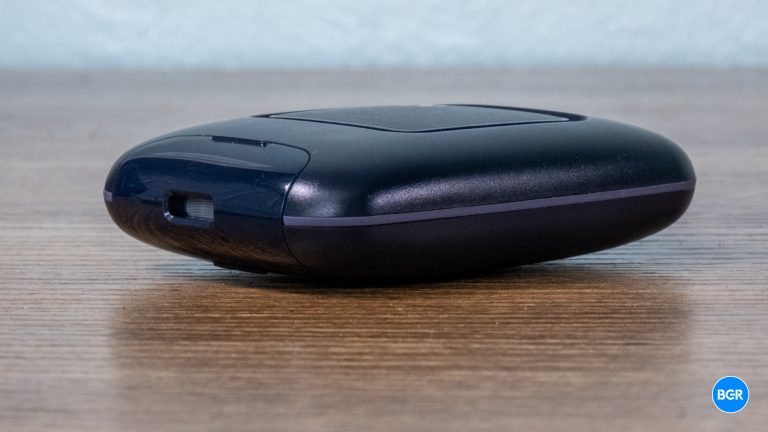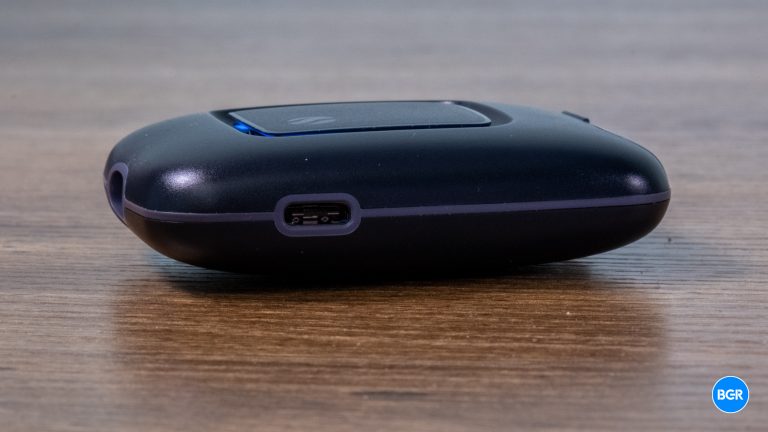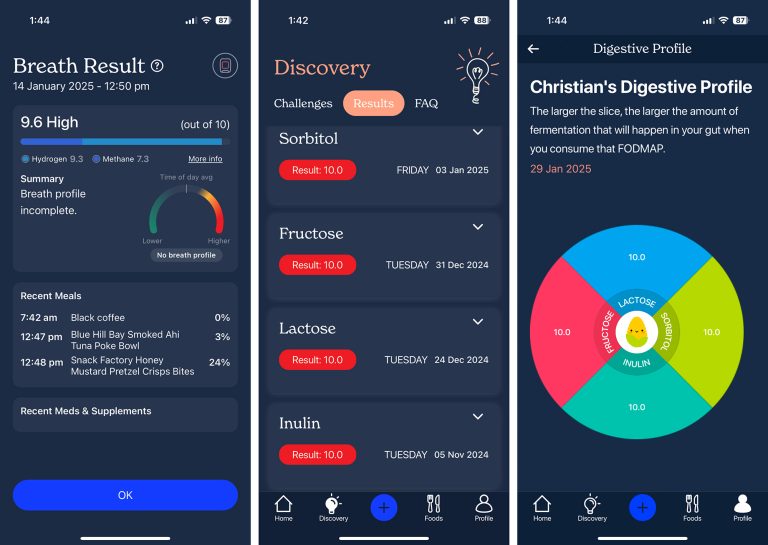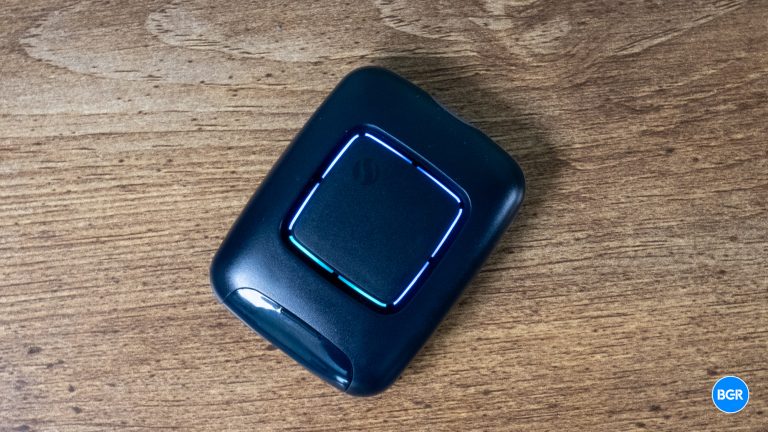FoodMarble Aire 2
The FoodMarble Aire 2 claims to be able to use breath-testing to track gut issues — but does it really help track down gut issues?
Pros
- Highly portable
- Decently-designed apps
- Could be used to track trends
Cons
- A little expensive
- A lot of work
| Buy From | List Price | Sale Price | |
|---|---|---|---|
| FoodMarble | $249 | $249 | See It |
Health tech is becoming increasingly popular, but beyond the average health trackers that can all effectively track things like sleep and activity, more and more consumer devices are being released for more niche needs. A perfect example of this is the Foodmarble Aire 2, a tiny device that monitors the gases in your breath.
The goal of the device is essentially to help users monitor and gain control over gut issues they might be experiencing — from previously diagnosed diseases like SIBO and IBS, to simple issues like bloating and too much gas.
But does it actually help? Is Foodmarble worth investing in, or should you stick to more conventional methods like elimination diets?
A science lesson
Research around the gut is continuing to expand. The basic idea behind FoodMarble is that when we eat and gut digests food, the many different kinds of bacteria in it produce gases like carbon dioxide, oxygen, nitrogen, hydrogen, and methane. Those last two are the gases that are particularly of interest for FoodMarble and the two gases that the company claims the Aire 2 can track.

Why those two gases? According to FoodMarble, food that isn’t absorbed properly in the stomach and small intestine travels to the large intestine, where it’s broken down by bacteria in a process called fermentation. During this process, gases like hydrogen and methane are released. If these gases build up too quickly, they can cause digestive symptoms like bloating and abdominal pain — but they can also cross into other areas of the body, and cross into the lungs, which is how the Aire 2 tracks their buildup.
To be clear, FoodMarble is quick to note that the Aire 2 should not be used as a tool to diagnose medical issues like SIBO and IBS. Instead, it’s built to be a day-to-day tool that can help users track which foods aggravate symptoms related to those diseases and other gut-related issues that users might be experiencing.

Along with the device itself, users can purchase sachets that they can use to test different food intolerances they might be experiencing. There are different sachets for fructose, lactose, inulin, and sorbitol, with these particular tests aimed at tracking down which of the four FODMAPs you might be sensitive to. Without diving too deep, FODMAPs are essentially carbohydrates that are found in food and can cause gastrointestinal symptoms.
I was particularly interested in this device before being tested for SIBO myself. I started using the FoodMarble Aire 2 before the test and continued using it after the test. Spoiler alert: my SIBO test, which tracks the same gases as the Aire 2, came back negative, but you might not have guessed that based on the results that the Aire 2 was showing.
Getting started
If you purchase both the Aire 2 and the Food Sensitivity Kit, you’ll have a number of different tasks to complete as part of using the device for actual symptom tracking. FoodMarble splits up these tasks into three stages. There’s the baseline stage in which you’ll go about your life and conduct breath tests at set times over the day. The idea is that both the app and you will get an idea of how your body reacts to different foods. During this stage, you’ll also be asked to track food, symptoms, and even other things like sleep and stress. This stage takes around a week.
After the baseline stage, you’ll be asked to cut out hard-to-digest FODMAPs while continuing to log your meals and conduct breath tests with the device. Last but not least is the discovery stage, which is when you’ll use the sachets in the Food Intolerance Kit to discover which FODMAPs you’re sensitive to.
It’s actually quite a bit of work, especially if you’re not used to tracking your food and other things like stress. The food library built into the app isn’t necessarily all that comprehensive, and if you’re doing everything the app asks you to, you’ll be doing a breath test quite a few times each day. Of course, it’s less work than having to do all of these things in a medical setting, but you’ll still need to remember to track everything.

So, what were my results of the food sensitivity tests? Well, every single test came back with a 10 out of 10 score, seemingly indicating that I’m highly sensitive to all four of the tested carbohydrates. Frankly, it was at this stage that I became much more skeptical of the device and the program. Anecdotally, I experienced drastically different symptoms depending on the test, but the device essentially ranked all of them as very high for my digestive system. To be clear, I followed the included instructions closely, ensuring that I was eating low-FODMAP foods the day before, not eating at all the morning of the test, and so on.
To make matters even more confusing, I had a doctor-ordered Trio Smart test while reviewing the Aire 2 — which itself tracks hydrogen and methane. The results of that test came back negative, which is to say that both gases were within normal range. In fact, they weren’t even close to being outside the normal range, throwing the Aire 2’s results into question.
FoodMarble, for its part, says that the results I experienced, and the difference in results between the Aire 2 and the Trio Smart, are actually not that unusual. FoodMarble CEO Aonghus Shortt, Ph.D explained to me that the carbohydrates tested with the Aire 2 are different than those tested by the Trio Smart, and that methane levels can fluctuate based on things like travel, illness, and so on. FoodMarble also highlighted the fact that a test like the Trio Smart is more focused on issues with the small intestine, and as such, it’s a 120-minute test. The Aire 2 is a little more focused on the entire digestion process, and any gases emitted by the large intestine will take longer.
Further, it’s important to highlight that FoodMarble has put its technology through lab tests in an effort to prove its accuracy. Indeed, those lab tests did find that the Aire 2 was consistent with clinical-grade devices.
Long-term use
All this does highlight one issue associated with health tracking gadgets: the issue of listening more to a device than what your body is telling you.
It’s an issue common with sleep tracking. Sleep tracking can be very useful for identifying trends and finding ways to get better sleep, but it shouldn’t necessarily be taken as gospel. Hopefully, if you sleep well, any sleep tracker that you use will tell you so. But what if you wake up in the morning feeling perfectly refreshed and then look at your sleep data only to find that it says you had a horrible night’s sleep? The psychological effects of being told that you actually slept poorly might make you suddenly find that you start feeling a little more tired, something that wouldn’t have happened if you hadn’t looked at your sleep data.
So, how does the FoodMarble Aire 2 fit into that equation? Basically, it should be used as a tool to help you narrow down symptoms that you’re already experiencing, and perhaps not all that useful as a way of finding new issues that you didn’t already know you had. FoodMarble agrees with that — Shortt mentioned to me that any changes you consider to your diet should depend on whether or not you’re experiencing symptoms like excessive bloating and abdominal pain. That’s perhaps why logging the symptoms is such a big part of the FoodMarble Aire 2 process — it could inform your diet just as much as the breath tests.

If the Aire 2 is able to track relatively accurately, then it’s possible it could help with some issues — though again, you’ll have to be careful with how much you trust the device. Even if you aren’t diagnosed with an actual GI issue, that doesn’t mean that you’re not more sensitive to some foods than others. That said, if you’re going to track entirely based on symptoms, then you probably don’t need a device like the Aire 2 at all — just a good ol’ food and symptom diary. If you are willing to spend some money, you could go a step further and download an app like Cara Care, which lets you track your food and symptoms without the breath testing.
That said, the Aire 2 could be useful for some users in tracking trends. Like other health tracking devices, even if the results aren’t completely accurate to a medical standard, they should at least be consistently inaccurate each time you conduct them. That means that you could, for example, track trends over time — seeing what foods are more problematic for you, and disregarding judgements from the device on those results, as being “high” or “low.”
So, what’s the verdict?
The food intolerance kit really did not help me at all. Being told that I’m highly sensitive to all four carbohydrates didn’t really track with my personal experiences, and I certainly wasn’t going to take the device’s word over symptoms that my body was actually feeling and the results from an actual medical test prescribed by my doctor.
But that doesn’t mean that the system as a whole isn’t useful. It’s entirely possible the device could help you track down trigger foods and track trends over time, as they relate to the foods you consume. You’ll have to do the work to get value from the system — and that will include tracking symptoms, all the food you eat, and other factors. If you do so, and you’re sure that simply tracking those things without the breath tests wouldn’t help, then it’s worth considering the FoodMarble Aire 2. Just make sure to factor in your actual symptoms more than just the results of the breath tests.








